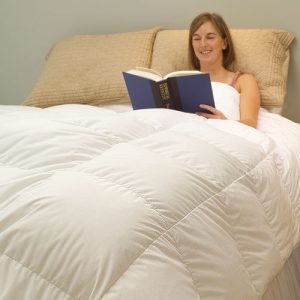
Down comforter – how to choose one?
There really is nothing as soft and warm as a down comforter for a good night’s sleep. However, choosing the right down comforter for your needs can sometimes be a nightmare. Here’s the lowdown on what you need to know:
What is natural down and why does it insulate so well?
Natural down consists of clusters of filaments from the underbelly of a waterfowl bird such as a duck or goose. Because of its three dimensional structure and ability to “loft”, each down cluster traps more air for its weight than any synthetic. The filaments interlock and overlap naturally to form a protective layer of still air that keeps warmth in and cold out. Natural down comforters consist of a mix of down material and feathers. As long as the comforter contains 75% down, it can be labeled in America as being “All Down” by manufacturers (Europe has higher standards). Because of this, it’s important to be aware of the down to feather content ratio. How do synthetic down comforters compare to the natural ones?
Synthetic down comforters provide a cost savings over natural goose or duck down comforters, but there are noticeable differences. A natural down comforter breathes more effectively than synthetics, provides more thermal warmth, and is usually more durable. Nevertheless, some of the new synthetic comforters like our Primaloft hypoallergenic comforters rated quite well with our reviewers.
Which birds provide the best down?
The best downs come from mature birds. Down from an immature bird tends to have poor filling power and collapses in a relatively short time. However, when age and maturity are equal, goose down is considered better than duck down. Eider down is considered the finest quality down material and thus the most expensive.
Why is fill power information important?
Fill power can tell you a lot about your comforter. The fill power (or how fluffy the comforter is) is the number of cubic inches one ounce of down will fill under laboratory conditions. A higher number on the fill power (typically a range of 600-800) means the comforter will be fluffier, warmer and last longer. Even though higher fill power costs more, in the long run it is worth having.
What does a cleanliness rating tell you?
The cleanliness of a down comforter is measured by an Oxygen test that indicates the amount of organic matter left after washing and a Turbidity test that is a measure of suspended solids in the material. The government standard for Oxygen is 10 but superior comforters have numbers lower than this. The scale for Turbidity goes from about 60 being unwashed to 550 being the best. Try to purchase a comforter that has a lower Oxygen number than 10 and a rather high scale Turbidity level.
What if I’m allergic to natural down material?
Many people mistakenly believe that they are allergic to feathers and down. However, studies have shown that they are actually experiencing a reaction to dust, dirt and other contaminants found in unwashed down and feathers. As an allergy sufferer, this is why selecting a comforter with acceptable cleanliness numbers on the above two tests might be your best bet. Look at our helpful Comforter Product Guide to compare these features.
What do I need to know about thread count?
Thread count is another useful feature to look for in your quest for the ideal down comforter. The higher the number of threads that are contained in one square inch of fabric, the lighter and smoother the comforter tends to feel. But keep in mind the highest number thread count of 360 for premium comforters may not be as durable as a 220-260 count comforter that is fine for most people.
What about the sewing construction of the comforter?
Comforters are generally sewn through or baffled. Baffling is an internal fabric wall that allows the fill to loft (puff up) more and adds strength to the comforter. Comforters that are sewn through are better for lightweight comforters only. Finally, the tightness of the weave on a comforter also prevents leakage of the fill to the outside world – commonly referred to as downproofing. Downproofness is measured in millimeters with the industry standard being 10 for air porosity.
In summary, while all of these factors are important for choosing the best comforter for you and your family, the enforcement of certain comforter manufacturer’s claims may be less stringent in some states. For this reason, it is always smart to go with a well-known brand whose claims you can trust. As is often the case with most healthy home products, you get what you pay for in comforter quality. Clearly the aim is to get the maximum warmth at the lightest weight. Be sure to purchase a duvet cover with your comforter to protect your investment and make it last for many restful nights.
